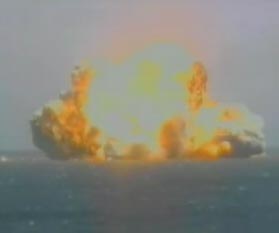Now on the news wires:
Sea Launch Mission Fails
Tuesday January 30, 8:23 pm ET
By John Antczak, Associated Press Writer
Sea Launch Rocket Blows Up During Satellite Launch in Pacific
LOS ANGELES (AP) -- A Sea Launch Co. rocket carrying a commercial communications satellite exploded Tuesday during launch from an oceangoing platform in the equatorial Pacific.
The Boeing Co.-built NSS-8 satellite was intended for Netherlands-based SES New Skies.
"There was an explosion as we were lifting off," Sea Launch spokeswoman Paula Korn said from the company's home port in Long Beach.
The platform is cleared of all personnel during launches, which are conducted remotely by a mission control team aboard a ship several miles away.
Korn did not know the condition of the self-propelled platform Odyssey, a converted oil platform.
The blast occurred at the scheduled 3:22 p.m. PST launch time. It was not known if the Zenit-3SL rocket actually lifted off the platform.
A webcast of the launch was halted and replaced with the message: "Anomaly on NSS-8 mission. Broadcast concluded."
A failure review oversight board will be formed to determine what happened, Korn said.
NSS-8 was to have been used for audio, video, data and Internet services for countries in Europe, Africa, the Middle East, the Indian subcontinent and Asia. SES New Skies has five other satellite in orbit and another under construction.
Based in the Port of Long Beach, Sea Launch is owned by Boeing, RSC-Energia of Moscow, Kvaerner ASA of Oslo, Norway, and SDO Yuzhnoye/PO Yuzhmash of Dnepropetrovsk, Ukraine.
The company sends its vessels to the equator for each mission because the physics of Earth's rotation allows rockets to carry heavier payloads than they could from other locations.
The system has had 23 previous launches since its first in 1999.
During the third launch, on March 12, 2000, the rocket failed to gain enough speed to reach orbit and a communications satellite was lost. During a June 28, 2004, launch, an upper-stage engine shut down prematurely and left the payload in a lower-than-planned orbit, but the satellite was later raised to the right position.
The Zenit-3SL has three stages, all fueled by kerosene and liquid oxygen. It is about 200 feet tall and 14 feet in diameter at its widest.
Sea Launch Mission Fails
Tuesday January 30, 8:23 pm ET
By John Antczak, Associated Press Writer
Sea Launch Rocket Blows Up During Satellite Launch in Pacific
LOS ANGELES (AP) -- A Sea Launch Co. rocket carrying a commercial communications satellite exploded Tuesday during launch from an oceangoing platform in the equatorial Pacific.
The Boeing Co.-built NSS-8 satellite was intended for Netherlands-based SES New Skies.
"There was an explosion as we were lifting off," Sea Launch spokeswoman Paula Korn said from the company's home port in Long Beach.
The platform is cleared of all personnel during launches, which are conducted remotely by a mission control team aboard a ship several miles away.
Korn did not know the condition of the self-propelled platform Odyssey, a converted oil platform.
The blast occurred at the scheduled 3:22 p.m. PST launch time. It was not known if the Zenit-3SL rocket actually lifted off the platform.
A webcast of the launch was halted and replaced with the message: "Anomaly on NSS-8 mission. Broadcast concluded."
A failure review oversight board will be formed to determine what happened, Korn said.
NSS-8 was to have been used for audio, video, data and Internet services for countries in Europe, Africa, the Middle East, the Indian subcontinent and Asia. SES New Skies has five other satellite in orbit and another under construction.
Based in the Port of Long Beach, Sea Launch is owned by Boeing, RSC-Energia of Moscow, Kvaerner ASA of Oslo, Norway, and SDO Yuzhnoye/PO Yuzhmash of Dnepropetrovsk, Ukraine.
The company sends its vessels to the equator for each mission because the physics of Earth's rotation allows rockets to carry heavier payloads than they could from other locations.
The system has had 23 previous launches since its first in 1999.
During the third launch, on March 12, 2000, the rocket failed to gain enough speed to reach orbit and a communications satellite was lost. During a June 28, 2004, launch, an upper-stage engine shut down prematurely and left the payload in a lower-than-planned orbit, but the satellite was later raised to the right position.
The Zenit-3SL has three stages, all fueled by kerosene and liquid oxygen. It is about 200 feet tall and 14 feet in diameter at its widest.






